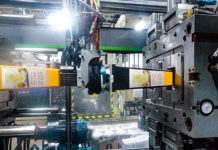by AWA Alexander Watson Associates
Incorrect packaging, storage and storage conditions all have an adverse effect on the processing of in-mold labels (IMLs) in subsequent processes. For example, research¹ has shown that the static receptivity will be negatively affected when stored in high humidity conditions – irrespective of film type, packaging design, charging method or topcoat chemistry.
A study from AWA (Alexander Watson Associates) recommends the following:
- A typical method of packaging labels is in banded bundles, face down, in suitably sized and manageable cardboard boxes. A comparison of packaging methods showed no direct benefit in packaging IMLs in shrink-wrapped bundles inside boxes or as bagged bundles in boxes.
- Rolls of label materials should be stored on end (vertical storage).
- The ideal storage conditions for IMLs often are quoted as RH 50 percent ±5 percent, 21 degrees Celcius ±2 degrees Celcius. Storage temperatures and relative humidity outside these limits will have an adverse effect on label performance. Research shows that static receptivity is especially affected by high humidity – cavitated films more so than solid films.
- Materials should not be stored near sources of heat and ignition, or in direct sunlight.
- Do not unwrap pallets or boxes until required.
- Long term storage should be undertaken in environmentally controlled storage conditions.
- Storage conditions should be clean, dry and moisture-free.
- Standard stock rotation practices should be followed – first in/first out and attention should be paid to any supplier recommendations on storage, shelf life and use.
- Labels should be removed from packaging and left to condition under the ambient room conditions in areas of use for at least 24 hours before processing.
Materials stored and used under these conditions should retain a specified performance for up to six months. However, these recommendations are guidelines, and label performance after storage also will be a function of label materials and constructions.
Reference: 1. Inkworks Printing/Inland Label Presentation, AWA IMLCON 11, Phoenix 2011.
These recommendations were excerpted from the “IN-MOLD LABEL TECHNICAL MANUAL & TEST METHODS” report by AWA Alexander Watson Associates, a leading international market research and marketing advisory services provider singularly focused on the specialty packaging, coating, converting and labeling industries. To request the full report, visit www.awa-bv.com.




